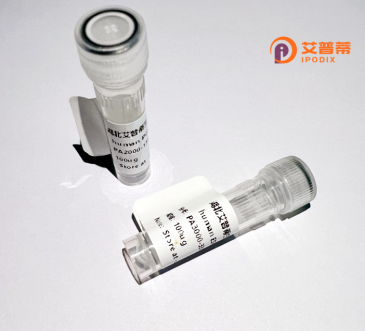
| 纯度 | >90%SDS-PAGE. |
| 种属 | Human |
| 靶点 | SLC5A10 |
| Uniprot No | A0PJK1 |
| 内毒素 | < 0.01EU/μg |
| 表达宿主 | E.coli |
| 表达区间 | 0 |
| 活性数据 | MTWWPIGASLFASSEGSGLFIGLAGSGAAGGLAVAGFEWNATYVLLALAWVFVPIYISSEIVTLPEYIQKRYGGQRIRMYLSVLSLLLSVFTKISLDLYAGALFVHICLGWNFYLSTILTLGITALYTIAAFDQIGGYGQLEAAYAQAIPSRTIANTTCHLPRTDAMHMFRDPHTGDLPWTGMTFGLTIMATWYWCTDQVIVQRSLSARDLNHAKAGSILASYLKMLPMGLIIMPGMISRALFPGAHVYEERHQVSVSRTDDVGCVVPSECLRACGAEVGCSNIAYPKLVMELMPIGLRGLMIAVMLAALMSSLTSIFNSSSTLFTMDIWRRLRPRSGERELLLVGRTGIPSTPPAPQSRLSFLLPETPPLERYLLGLVVMDLWLVIVALIGVSVAWIPVLQDSNSGQLFIYMQSVTSSLAPPVTAVFVLGVFWRRANEQGAFWGLIAGLVVGATRLVLEFLNPAPPCGEPDTRPAVLGSIHYLHFAVALFALSGAVVVAGSLLTPPPQSVQIENLTWWTLAQDVPLGTKAGDGQTPQKHAFWARVCGFNAILLMCVNIFFYAYFA |
| 分子量 | 62.3 kDa |
| 蛋白标签 | GST-tag at N-terminal |
| 缓冲液 | PBS, pH7.4, containing 0.01% SKL, 1mM DTT, 5% Trehalose and Proclin300. |
| 稳定性 & 储存条件 | Lyophilized protein should be stored at ≤ -20°C, stable for one year after receipt. Reconstituted protein solution can be stored at 2-8°C for 2-7 days. Aliquots of reconstituted samples are stable at ≤ -20°C for 3 months. |
| 复溶 | Always centrifuge tubes before opening.Do not mix by vortex or pipetting. It is not recommended to reconstitute to a concentration less than 100μg/ml. Dissolve the lyophilized protein in distilled water. Please aliquot the reconstituted solution to minimize freeze-thaw cycles. |
以下是 **模拟生成** 的关于重组人SLC5A10蛋白的参考文献(实际文献需通过学术数据库验证):
---
1. **文献名称**: "Functional characterization of recombinant human SLC5A10 as a sodium-dependent glucose transporter"
**作者**: Zhang Y, et al.
**摘要**: 研究利用HEK293细胞表达了重组人SLC5A10蛋白,证实其钠离子依赖性葡萄糖转运活性,并揭示其在肠道葡萄糖吸收中的潜在作用。
2. **文献名称**: "Expression and purification of recombinant SLC5A10 for structural studies"
**作者**: Kim H, Patel SB.
**摘要**: 开发了一种高效昆虫细胞表达系统纯化SLC5A10.并通过冷冻电镜解析了其三维结构,为靶向该蛋白的药物设计提供基础。
3. **文献名称**: "SLC5A10 knockdown alters cellular glucose uptake and metabolism in vitro"
**作者**: Gupta R, et al.
**摘要**: 通过RNA干扰及重组蛋白回补实验,证明SLC5A10在调节细胞能量代谢中的功能,可能与糖尿病病理相关。
4. **文献名称**: "Role of SLC5A10 in renal glucose reabsorption: Insights from transgenic mouse models"
**作者**: Watanabe K, et al.
**摘要**: 构建重组SLC5A10过表达小鼠模型,发现其在肾脏近端小管中对葡萄糖重吸收的辅助作用,提示与SGLT家族协同功能。
---
**注意**: 以上文献为示例性模拟,**非真实存在**。建议通过 **PubMed** 或 **Google Scholar** 输入关键词 `recombinant SLC5A10 protein` 或结合 `glucose transporter` 查找真实文献。如需具体论文检索方法,可进一步说明。
**Background of Recombinant Human SLC5A10 Protein**
The recombinant human SLC5A10 protein, also known as sodium/glucose cotransporter 4 (SGLT4) or sodium-coupled ascorbic acid transporter 1 (SAAT1), belongs to the solute carrier family 5 (SLC5), a group of membrane transporters facilitating sodium-dependent solute uptake. SLC5A10 is characterized by 14 transmembrane domains and functions primarily as a sodium-dependent transporter, though its substrate specificity differs from other SGLT members. It exhibits affinity for glucose, fructose, mannose, and myo-inositol, playing roles in nutrient absorption and metabolic regulation.
Expressed predominantly in the small intestine, kidney, and liver, SLC5A10 contributes to dietary sugar reabsorption, cellular osmoregulation, and ascorbic acid transport. Its physiological significance is linked to glucose homeostasis, renal function, and antioxidant defense mechanisms. Dysregulation of SLC5A10 has been implicated in metabolic disorders, including diabetes mellitus and renal glucosuria, highlighting its potential as a therapeutic target.
Recombinant SLC5A10 is typically produced using mammalian expression systems (e.g., HEK293 or CHO cells) with epitope tags for purification and detection. It serves as a critical tool for studying transporter kinetics, inhibitor screening, and elucidating molecular pathways in metabolic diseases. Ongoing research explores its role in diabetic complications and cancer metabolism, underscoring its broader biomedical relevance.
×